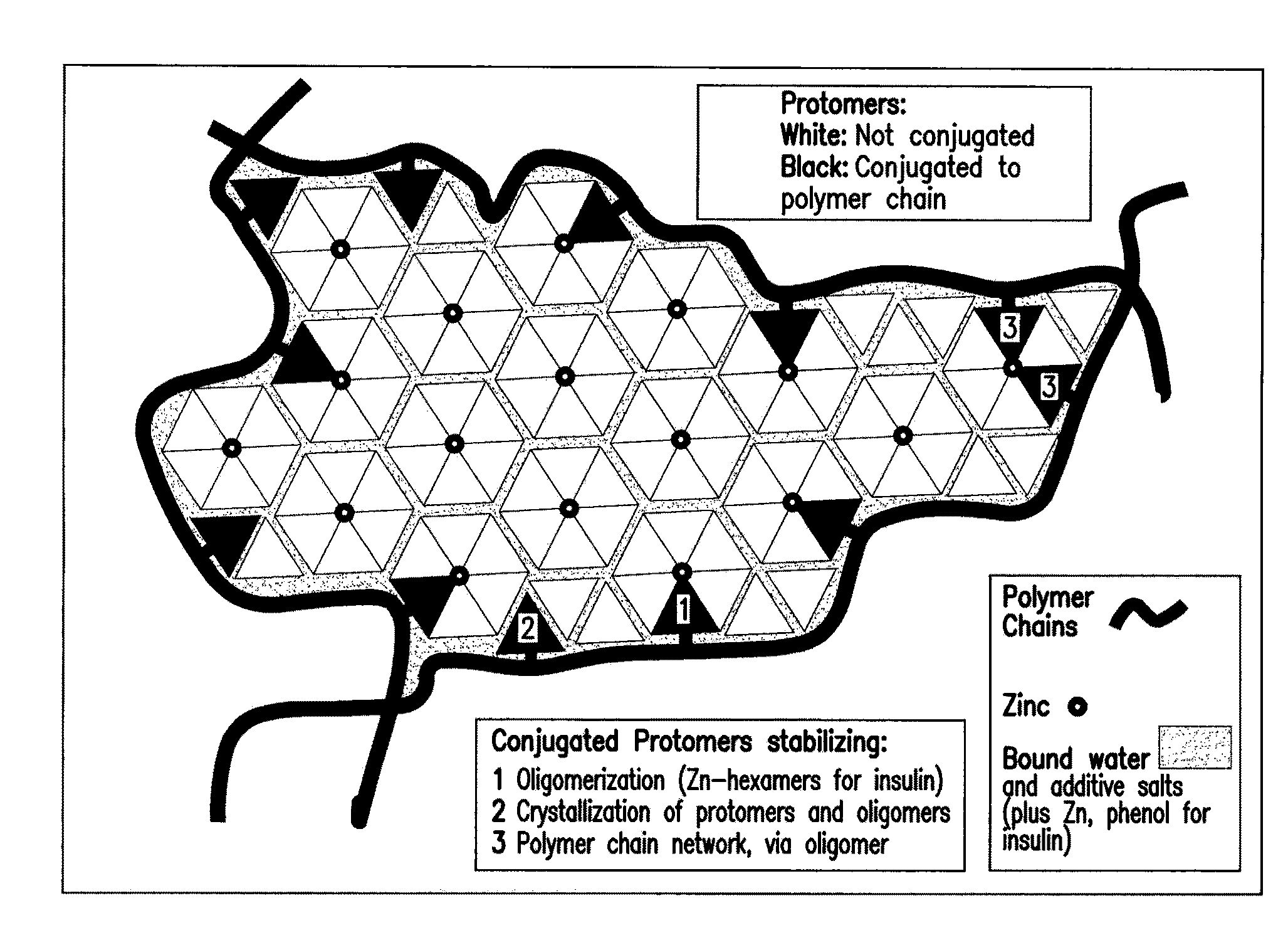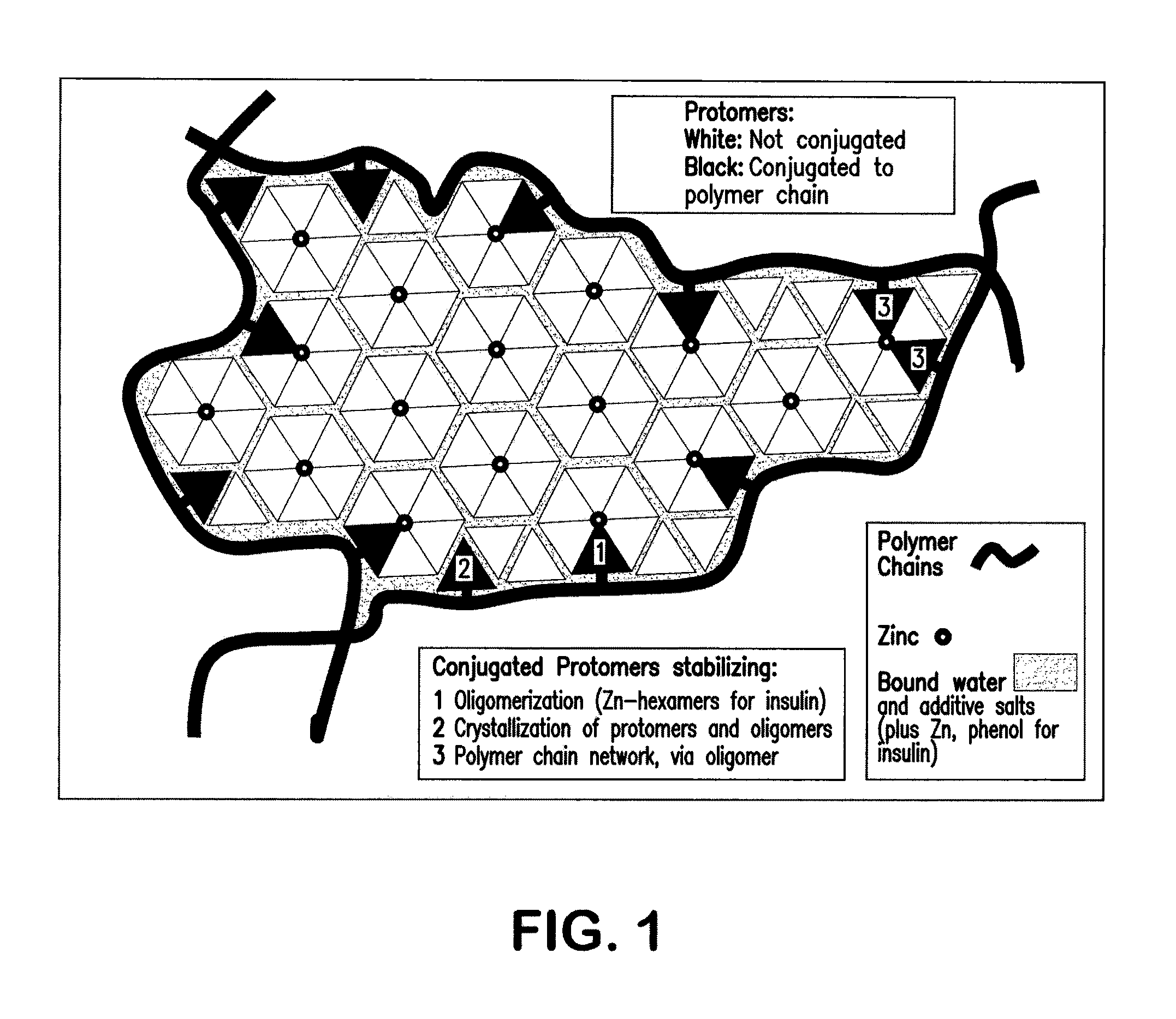Polymer-stabilized liposomal compositions and methods of use
a polymer-stabilized, composition technology, applied in the direction of antibody medical ingredients, peptide/protein ingredients, metabolism disorders, etc., can solve the problems of limiting the release of biologics through gel diffusion, limiting the release of biologics, and presenting an inherent problem for the delivery of structurally intact biologic macromolecules
- Summary
- Abstract
- Description
- Claims
- Application Information
AI Technical Summary
Benefits of technology
Problems solved by technology
Method used
Image
Examples
example 1
Preparation of Polymer-Insulin Conjugate
[0189]Activation of PEA. The PEA (65 kD) co-polymer (386 mg, 209 μmol of CO2H) was dissolved in DMF (1.0 mL) and stirred with N-hydroxysuccinamide (13.22 mg, 115 μmol) and DCC (23.78 mg, 115 μmol) at RT for 24 h. The reaction mixture was filtered through a frit (0.2 μm) and washed with 0.5 mL of DMF.
[0190]Conjugation (PEA-Ins). The activated ester in DMF was mixed with 1 equiv of insulin (597 mg) in DMSO (3 mL) and diisopropylethyl amine (54 μL, 3.0 equiv) and stirred for 48 h. PEA-Insulin (PEA-Ins) conjugate solution was examined by GPC and forwarded to the next step, synthesis of Core Material.
Fabrication of Polymer-Stabilized Liposomal Particles (Oil-in-Water Method)
[0191]Step 1: Stabilization of the biologic with polymer (Core Material PEA-Ins-Ins[Hex]): All solutions and dialysis were stored at 4° C. in deaerated solutions.
[0192]Stock solution A: 650 mg zinc sulfate and 490 mg phenol were dissolved in 20 ml water to give a concentration o...
example 2
Bioactivity of Insulin Delivered Orally in a Pea-Stabilized Liposomal Formulation Encapsulated in Gelatin Capsules Covered with an Enteric Coating
[0208]PEA-insulin formulation, made as described in Example 1 above, was encapsulated in gelatin capsules that were then encased within an enteric coating. The capsules were administered to fasted rats such that each rat received a dose of 60 IU / kg insulin. At the time points shown in FIGS. 5A and B, blood was collected to measure blood glucose and insulin levels compared to a non-polymer-encapsulated insulin dose of 1 IU / kg injected subcutaneously (subQ).
[0209]A separate study using contrast agent-filled capsules showed that the capsules do not always exit the stomach within a 5 hour time period. Therefore, based on the results of the contrast agent study, the results shown in FIGS. 5A and B are separately designated as “Delivered” capsules, if glucose lowering and blood insulin were measured, meaning the capsules ultimately delivered the...
example 3
Fabrication of Polymer-Stabilized Liposomal Particles by Oil-in-Oil Method
[0213]Lecithin (25.8 mg), cholic acid (15.5 mg), cholesterol (2.1 mg), capmul C10 (3.1 mg), and oleic acid (2.1 mg) was dissolved in 0.5 mL of methanol. This solution was then mixed with PEA-Ins-Ins[Hex] (53.1 mg) dissolved in 1.0 mL HFIP to form a discontinuous phase. A continuous phase was made by mixing 0.4% Span 80 into 80 mL of cottonseed oil. The discontinuous phase was premixed with 12% by volume of the continuous phase to yield a pre-emulsion. This pre-emulsion was added to the continuous phase and emulsified at room temperature for 15 min at 6000 rpm. The organic solvents were removed by rotoevaporation. The material was collected on a 0.8 μm nylon filter. After lyophilization the average mass yield of 6 batches was 61±2 mg of material obtained as a white powder to give a 61±2% yield (wt / wt). The insulin loading in the particles (wt / wt) was determined to be 67±4% by HPLC and 63±3% by GPC. The DLS anal...
PUM
| Property | Measurement | Unit |
|---|---|---|
| Fraction | aaaaa | aaaaa |
| Time | aaaaa | aaaaa |
| Time | aaaaa | aaaaa |
Abstract
Description
Claims
Application Information
 Login to View More
Login to View More - R&D
- Intellectual Property
- Life Sciences
- Materials
- Tech Scout
- Unparalleled Data Quality
- Higher Quality Content
- 60% Fewer Hallucinations
Browse by: Latest US Patents, China's latest patents, Technical Efficacy Thesaurus, Application Domain, Technology Topic, Popular Technical Reports.
© 2025 PatSnap. All rights reserved.Legal|Privacy policy|Modern Slavery Act Transparency Statement|Sitemap|About US| Contact US: help@patsnap.com



